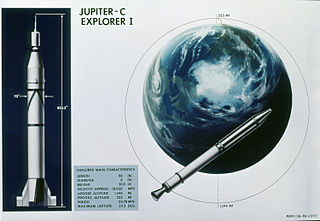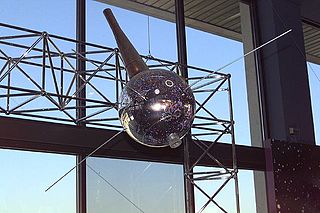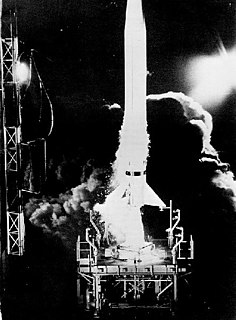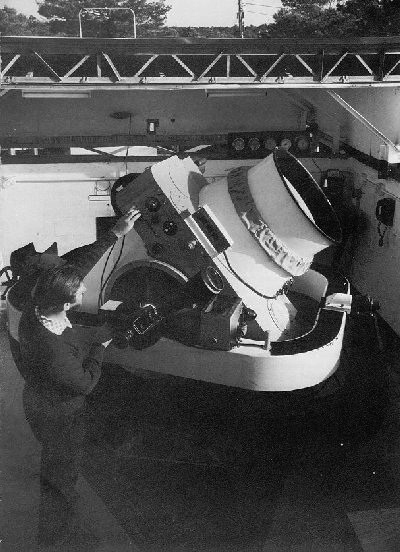
Sputnik 1 was the first artificial Earth satellite. It was launched into an elliptical low Earth orbit by the USSR on 4 October 1957 as part of the Soviet space program. It orbited for three weeks before its batteries ran out. The satellite then silently continued to orbit the planet for two months before it fell back into the atmosphere on 4 January 1958.

Explorer 1 was the first satellite launched by the United States and was part of the U.S. participation in the International Geophysical Year (IGY). The mission followed the first two satellites the previous year; the Soviet Union's Sputnik 1 and Sputnik 2, beginning the Cold War Space Race between the two nations.

Vanguard TV-3, was the first attempt of the United States to launch a satellite into orbit around the Earth, after the successful Soviet launches of Sputnik 1 and Sputnik 2. Vanguard TV-3 was a small satellite designed to test the launch capabilities of the three-stage Vanguard and study the effects of the environment on a satellite and its systems in Earth orbit. It was also to be used to obtain geodetic measurements through orbit analysis. Solar cells on Vanguard TV-3 were manufactured by Bell Laboratories.

Vanguard 1 is an American satellite that was the fourth artificial Earth-orbiting satellite to be successfully launched ; it was launched 17 March 1958. Vanguard 1 was the first satellite to have solar electric power. Although communications with the satellite were lost in 1964, it remains the oldest human-made object still in orbit, together with the upper stage of its launch vehicle.
Project Vanguard was a program managed by the United States Naval Research Laboratory (NRL), which intended to launch the first artificial satellite into Earth orbit using a Vanguard rocket as the launch vehicle from Cape Canaveral Missile Annex, Florida.

The Saturn family of American rockets was developed by a team of mostly German rocket scientists led by Wernher von Braun to launch heavy payloads to Earth orbit and beyond. The Saturn family used liquid hydrogen as fuel in the upper stages. Originally proposed as a military satellite launcher, they were adopted as the launch vehicles for the Apollo Moon program. Three versions were built and flown: the medium-lift Saturn I, the heavy-lift Saturn IB, and the super heavy-lift Saturn V.

Vanguard 2 is an Earth-orbiting satellite launched 17 February 1959 at 15:55:02 GMT, aboard a Vanguard SLV-4 rocket as part of the United States Navy's Project Vanguard. The satellite was designed to measure cloud cover distribution over the daylight portion of its orbit, for a period of 19 days, and to provide information on the density of the atmosphere for the lifetime of its orbit. As the first weather satellite and one of the first orbital space missions, the launch of Vanguard 2 was an important milestone in the Space Race between the United States and the Soviet Union. As of March 2021, Vanguard 2 was still in orbit.

Vanguard 3 is a scientific satellite that was launched into Earth orbit by the Vanguard SLV-7 on 18 September 1959, the third successful Vanguard launch out of eleven attempts. Vanguard rocket: Vanguard Satellite Launch Vehicle-7 (SLV-7) was an unused Vanguard TV-4BU rocket, updated to the final production Satellite Launch Vehicle (SLV).

A Schmidt camera, also referred to as the Schmidt telescope, is a catadioptric astrophotographic telescope designed to provide wide fields of view with limited aberrations. The design was invented by Bernhard Schmidt in 1930.

The United States Space Surveillance Network detects, tracks, catalogs and identifies artificial objects orbiting Earth, e.g. active/inactive satellites, spent rocket bodies, or fragmentation debris. The system is the responsibility of United States Space Command and operated by the United States Space Force.

James Gilbert Baker was an American astronomer and designer of optics systems.

Operation Moonwatch was an amateur science program formally initiated by the Smithsonian Astrophysical Observatory (SAO) in 1956. The SAO organized Moonwatch as part of the International Geophysical Year (IGY) which was probably the largest single scientific undertaking in history. Its initial goal was to enlist the aid of amateur astronomers and other citizens who would help professional scientists spot the first artificial satellites. Until professionally manned optical tracking stations came on-line in 1958, this network of amateur scientists and other interested citizens played a critical role in providing crucial information regarding the world's first satellites.

Milton William Rosen was a United States Navy engineer and project manager in the US space program between the end of World War II and the early days of the Apollo Program. He led development of the Viking and Vanguard rockets, and was influential in the critical decisions early in NASA's history that led to the definition of the Saturn rockets, which were central to the eventual success of the American Moon landing program. He died of prostate cancer in 2014.
The Minitrack Network was the first U.S. satellite tracking network to become operational, in 1957. It was used to track the flights of Sputnik, Vanguard, Explorer, and other early space efforts. Minitrack was the progenitor of Spacecraft Tracking and Data Acquisition Network (STADAN) and the Manned Space Flight Network (MSFN).

Vanguard TV-3BU, also called Vanguard Test Vehicle-Three Backup, was the second flight of the American Vanguard rocket. An unsuccessful attempt to place an unnamed satellite, Vanguard 1B, into orbit, the rocket was launched on 5 February 1958. It was launched from LC-18A at the Cape Canaveral Air Force Station. Fifty-seven seconds after launch, control of the vehicle was lost and it failed to achieve orbit. At 57 seconds, the booster suddenly pitched down. The skinny second stage broke in half from aerodynamic stress, causing the Vanguard to tumble end-over-end before range safety officer sent the destruct command. The cause of the failure was attributed to a spurious guidance signal that caused the first stage to perform unintended pitch maneuvers. Vanguard TV-3BU only reached an altitude of 6.1 km (3.8 mi), the goal was 3,840 km (2,390 mi).

Boller and Chivens was an American manufacturer of high-quality telescopes and spectrographs headquartered in South Pasadena, California.
Project Space Track was a research and development project of the US Air Force, to create a tracking system for all artificial satellites of the Earth and space probes, domestic and foreign.

Vanguard TV-0, also called Vanguard Test Vehicle-Zero, was the first sub-orbital test flight of a Vanguard rocket as part of the Project Vanguard.

Vanguard TV-1, also called Vanguard Test Vehicle-One, was the second sub-orbital test flight of a Vanguard rocket as part of the Project Vanguard. Vanguard TV-1 followed the successful launch of Vanguard TV-0 a one-stage rocket launched in December 1956.

Vanguard TV-2, also called Vanguard Test Vehicle-Two, was the third suborbital test flight of a Vanguard rocket as part of Project Vanguard. Successful TV-2 followed the successful launch of Vanguard TV-0 a one-stage rocket launched in December 1956 and Vanguard TV-1 a two-stage rocket launched in May 1957.

















